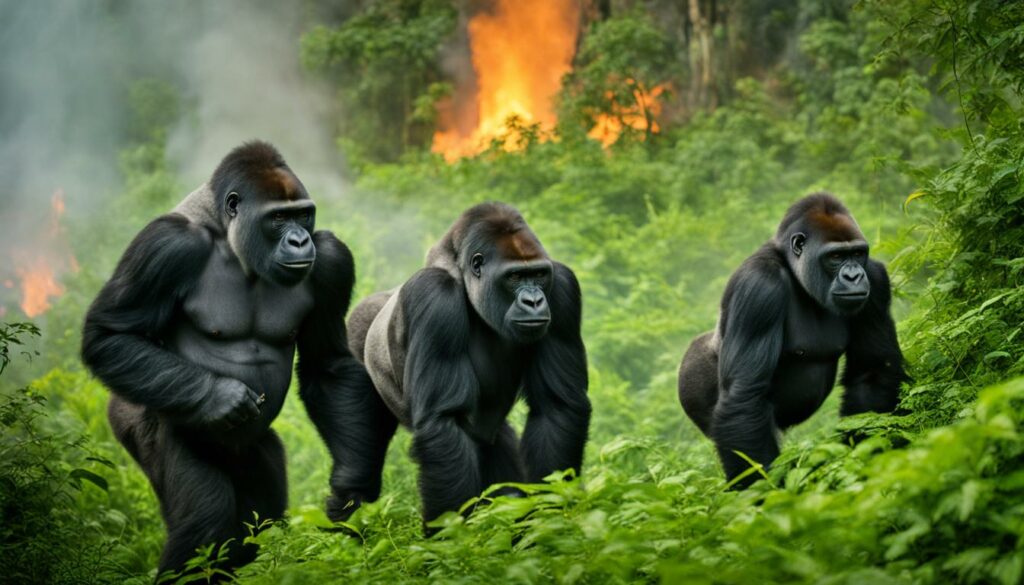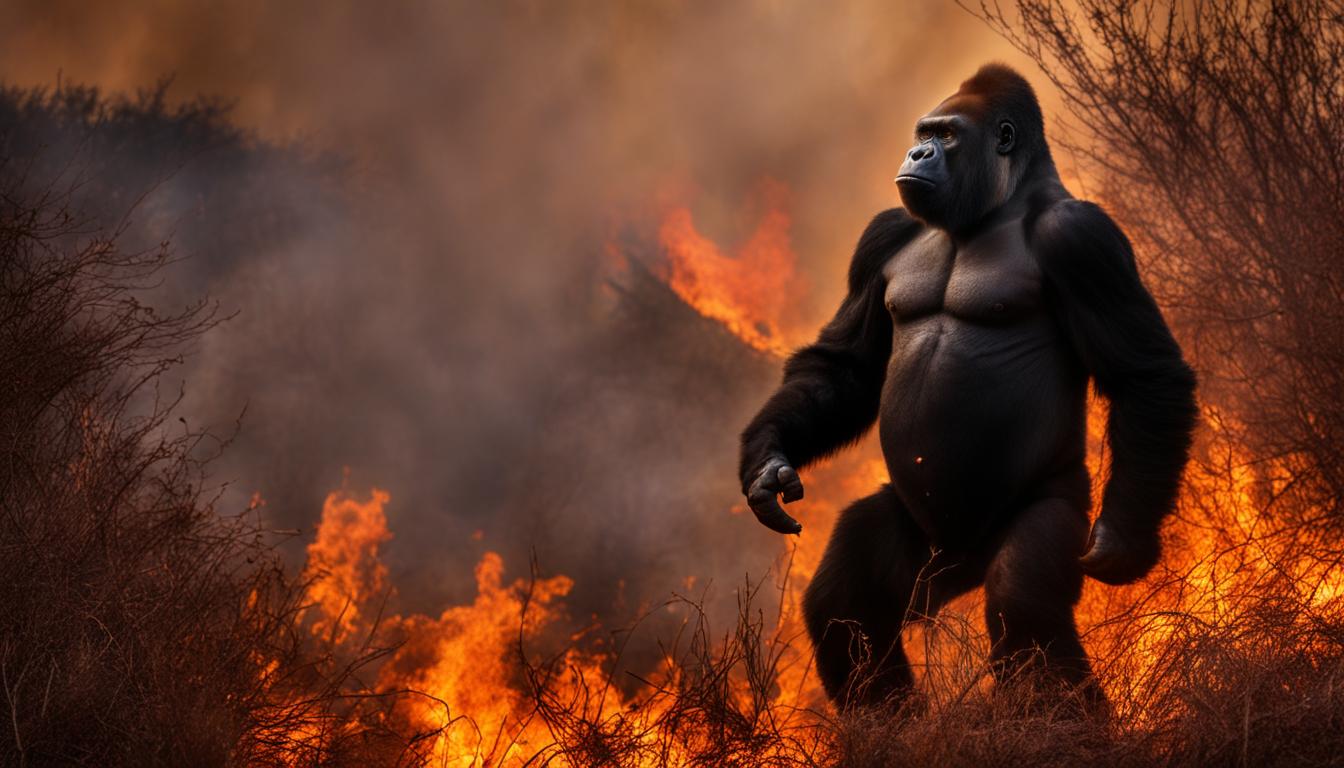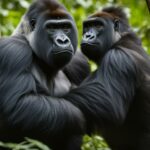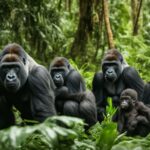Gorillas in their natural habitats are vulnerable to wildfires, which can have a significant impact on their behavior and overall survival. It is important to understand how gorillas respond to these fires in order to develop effective conservation strategies.
In this article, we will explore the adaptability of gorillas in their mountain habitats, the impact of climate change on gorilla habitat, threats posed by humans, and the importance of gorilla conservation. By raising awareness and taking action, we can work towards protecting gorillas and preserving their natural habitats.
The Adaptability of Mountain Gorillas
Mountain gorillas are a remarkable species known for their adaptability in various climates. They have evolved to survive in harsh mountainous regions, where temperatures can fluctuate drastically. Unlike other gorilla subspecies, mountain gorillas can tolerate colder temperatures, thanks to their thick fur and layer of fat that provides insulation. This adaptability allows them to inhabit a wide range of elevations, from dense forests to subalpine areas.
One key factor that contributes to the adaptability of mountain gorillas is their diverse diet. They are primarily herbivores, consuming a variety of plants, leaves, stems, and fruits. This flexibility in their food sources enables them to adjust to changes in their environment. For example, during periods of food scarcity, they can subsist on lower-quality vegetation or browse on new plant species that become available.
However, despite their remarkable adaptability, mountain gorillas are facing a significant threat from climate change. Rising global temperatures and shifting rainfall patterns are impacting their habitat and food sources. As temperatures increase, the suitable range for gorilla populations may shift higher up the mountains, reducing their available habitat. Changes in rainfall patterns can also affect the growth and abundance of particular plant species that gorillas rely on for sustenance.
It is essential to understand the impacts of climate change on mountain gorillas and their habitats to develop effective conservation strategies. By protecting their habitat, monitoring their populations, and promoting sustainable practices, we can help ensure the survival of these incredible creatures for generations to come.
Impact of Climate Change on Gorilla Habitat
Climate change has profound effects on the habitat of gorillas, leading to significant challenges for their survival. One of the primary concerns is habitat loss, as changing climatic conditions cause shifts in vegetation patterns and alter the availability of food sources for gorillas. With the increase in global temperatures, their preferred food sources may be forced to higher elevations, making it difficult for gorillas to access them. This can result in reduced food availability and ultimately impact their overall health and reproductive success.
Furthermore, changes in rainfall patterns due to climate change can increase the risk of forest fires in gorilla habitats. As the frequency and intensity of droughts and heatwaves increase, the vegetation becomes more susceptible to fire. This poses a direct threat to gorillas, as wildfires can destroy large areas of their habitats, leaving them without shelter and food. The risk of injury or death due to wildfires further exacerbates the challenges faced by gorillas in an already changing environment.
To better understand the impact of climate change on gorilla habitats, it is crucial to gather data on temperature changes, rainfall patterns, and vegetation shifts. These scientific insights can inform conservation efforts and help develop strategies to mitigate the effects of climate change on gorillas. By monitoring these changes, conservationists can identify areas that are most at risk and implement measures to protect and restore gorilla habitats.
| Impact of Climate Change on Gorilla Habitat | Key Factors |
|---|---|
| Habitat loss | Shifts in vegetation patterns, limited access to food sources |
| Risk of forest fires | Changes in rainfall patterns, increased vulnerability of vegetation |
| Conservation strategies | Data collection, monitoring, and restoration efforts |
Efforts to mitigate climate change globally are crucial for the long-term survival of gorillas and their habitats. Reducing greenhouse gas emissions and adopting sustainable practices can help slow down the rate of climate change, providing gorillas with a better chance to adapt to their changing environment. Additionally, conservation organizations play a vital role in advocating for gorilla conservation and raising awareness about the impact of climate change. Collaborative efforts between governments, communities, and individuals are essential to protect these magnificent creatures and ensure a sustainable future for them.
Threats Posed by Humans
Gorillas face numerous threats from human activities, which have a detrimental impact on their populations and habitats. One of the major threats is habitat destruction caused by human settlements and agricultural activities. As humans expand into gorilla habitats, forests are cleared to make way for homes, farmland, and infrastructure. This loss of habitat displaces gorillas, disrupts their natural behavior, and limits their access to food and shelter.
Another significant threat to gorillas is hunting and poaching. Gorillas are illegally targeted for bushmeat, traditional medicine, and the pet trade. Hunting and poaching not only reduce gorilla populations but also disrupt social structures within gorilla groups, resulting in long-term consequences for their survival. Efforts to combat illegal hunting and poaching are crucial to protect gorillas and ensure the viability of their populations.
Furthermore, humans can transmit diseases to gorillas, which can have devastating effects on their populations. Gorillas share a high degree of genetic similarity with humans, making them susceptible to various infectious diseases. When humans come into close contact with gorillas, through activities such as tourism or research, there is a risk of disease transmission. Measures to minimize contact between humans and gorillas, such as strict guidelines for visitors and researchers, are essential to mitigate this threat.
Threats Posed by Humans Table:
| Threat | Description |
|---|---|
| Habitat Destruction | Clearing of forests for human settlements and agriculture, leading to habitat loss for gorillas. |
| Hunting and Poaching | Illegal hunting and poaching for bushmeat, traditional medicine, and the pet trade, resulting in population decline and disruption of social structures. |
| Disease Transmission | Humans can transmit diseases to gorillas, causing severe health impacts and potential population decline. |
In conclusion, human activities pose significant threats to the survival and well-being of gorillas. Habitat destruction, hunting and poaching, and disease transmission all contribute to the decline of gorilla populations. Conservation efforts must focus on addressing these threats through sustainable development practices, strict enforcement of anti-poaching laws, and disease prevention measures. By recognizing and minimizing our impact on gorillas, we can ensure their continued existence for future generations.
Protecting Mountain Gorillas
Conservation efforts play a crucial role in protecting mountain gorillas and their habitats. Effective habitat monitoring is essential to ensure the well-being of gorillas and quickly identify any changes that may impact their survival. By closely monitoring their habitats, conservation organizations can take timely action to address threats such as deforestation, illegal mining, and encroachment by human settlements.
Disease prevention is another critical aspect of protecting mountain gorillas. These magnificent creatures share approximately 98% of their DNA with humans, making them susceptible to many of the same diseases. Minimizing direct contact between humans and gorillas through strict guidelines for gorilla tourism and educational programs can significantly reduce the risk of disease transmission. Regular health check-ups and veterinary care are also essential to detect and treat any potential diseases in gorilla populations.
Benefits of Gorilla Tourism
Gorilla tourism can be a powerful tool in gorilla conservation efforts. By generating revenue through responsible and sustainable tourism practices, conservation organizations can fund habitat protection initiatives, anti-poaching measures, and community development programs. The economic benefits of gorilla tourism can also incentivize local communities to support conservation efforts, as they directly experience the positive impact of preserving gorilla populations and their habitats.
| Conservation | Habitat Monitoring | Disease Prevention | Tourism |
|---|---|---|---|
| Protecting mountain gorillas and their habitats through various initiatives | Regular monitoring of gorilla habitats to identify and address threats | Minimizing the risk of disease transmission through guidelines and health check-ups | Responsible tourism practices that generate revenue for conservation efforts |
| Addressing threats such as deforestation, illegal mining, and encroachment by human settlements | Quick action to protect gorilla habitats from environmental degradation | Ensuring the well-being of gorilla populations through veterinary care | Funding anti-poaching measures and community development programs |
| Engaging local communities in conservation efforts through economic incentives | Monitoring changes in gorilla populations and behavior | Reducing direct contact between humans and gorillas | Promoting responsible and sustainable tourism practices |
| Creating awareness about the importance of gorilla conservation | Identifying and mitigating potential risks to gorilla populations | Supporting research and education programs | Contributing to the preservation of gorilla populations and their habitats |
Protecting mountain gorillas is a collective effort involving governments, conservation organizations, local communities, and tourists. By implementing effective conservation strategies, prioritizing habitat monitoring, preventing the transmission of diseases, and supporting responsible tourism, we can ensure the long-term survival of these incredible creatures and their unique habitats.
The Role of Individuals in Gorilla Conservation
When it comes to protecting gorillas and their habitats, individuals have an important role to play. By making donations to reputable organizations dedicated to gorilla conservation, you can contribute directly to efforts that aim to protect these magnificent creatures and their natural environments. Your financial support can fund initiatives such as habitat monitoring, anti-poaching patrols, and community-based conservation projects that help mitigate the threats gorillas face.
But conservation goes beyond just monetary contributions. You can also make a difference through your everyday choices and actions. One way to support gorilla conservation is by choosing sustainable products. By opting for products that are made in an environmentally responsible manner and do not contribute to habitat destruction, you can help reduce the demand for resources that threaten gorillas’ habitats.
Choosing sustainable products and embracing responsible consumption practices can have a positive impact on gorilla conservation. By making conscious choices, you can contribute to the preservation of these incredible animals and their habitats.
Responsible consumption practices extend to avoiding products made with wild animal parts, as the demand for these items fuels illegal poaching and contributes to the decline of gorilla populations. By refusing to purchase or engage in the trade of these products, you can help protect gorillas from harm and preserve the biodiversity of their ecosystems.

Overall, every individual has the power to make a difference in gorilla conservation. Through donations, sustainable product choices, and responsible consumption practices, you can contribute to the long-term survival of these incredible creatures and their habitats, ensuring that future generations can continue to marvel at their beauty and importance to our planet.
Importance of Climate Change Awareness
Climate change poses a significant threat to the survival of gorillas and their natural habitats. Increasing awareness about the impact of climate change is essential in order to inspire action and implement effective solutions. Education plays a crucial role in fostering a deeper understanding of the challenges faced by gorillas and the urgency of addressing climate change.
By educating individuals and communities about the link between human activities, greenhouse gas emissions, and the resulting consequences for gorilla habitats, we can encourage people to make more sustainable choices in their daily lives. This includes promoting energy conservation, reducing carbon footprints, and supporting renewable energy sources. Through education, we can empower individuals to become advocates for climate change mitigation and conservation efforts.
The Power of Global Action
While individual actions are important, the scale of the climate change challenge requires collective action on a global level. Governments, international organizations, and communities must come together to develop comprehensive strategies and policies to reduce greenhouse gas emissions and protect gorilla habitats. This includes implementing regulations on deforestation and illegal logging, promoting sustainable agriculture practices, and investing in green technologies.
“Climate change is a global problem that requires global solutions. It is only through collective action that we can preserve the natural habitats of gorillas and other vulnerable species for future generations.” – Conservation expert
Furthermore, international cooperation and support are necessary to provide resources and funding for climate change adaptation and mitigation efforts in gorilla habitats. This can include initiatives to restore degraded ecosystems, strengthen conservation programs, and enhance the resilience of local communities to climate impacts. By working together, we can make a significant difference in safeguarding gorillas and their ecosystems.
Conclusion:
Climate change awareness is not only about understanding the environmental impact, but also recognizing the interconnectedness of ecosystems and species. By raising awareness, promoting education, and taking global action, we can protect not only gorillas but also the entire planet from the devastating consequences of climate change. Together, we have the power to make a positive impact and secure a sustainable future for gorillas and future generations.
Conclusion
In conclusion, wildfires and climate change pose significant challenges for gorillas and their conservation. Gorillas in their natural habitats are vulnerable to wildfires, which can have a significant impact on their behavior and overall survival. Understanding how gorillas respond to these fires is crucial for developing effective conservation strategies.
Climate change also threatens gorillas and their habitats. Changes in rainfall patterns and shifts in food sources due to climate change can lead to habitat loss and disrupt the gorillas’ access to food and shelter. Additionally, human activities such as hunting, poaching, and disease transmission further endanger gorilla populations.
To protect gorillas, a multi-faceted approach is necessary. Habitat monitoring is essential for ensuring the well-being of gorillas and identifying any changes that may affect their survival. Disease prevention measures, like minimizing human-gorilla contact, are crucial to preserving their populations. Furthermore, responsible tourism and sustainable practices can contribute to conservation efforts. By raising awareness about the impact of climate change and taking individual and collective action, we can contribute to the long-term survival of gorillas and the preservation of their natural habitats.
Do Gorillas and Chimpanzees Have Similar Responses to Wildfires in Their Habitats?
Gorillas and chimpanzees’ response to wildfires in their habitats differ significantly. While gorillas may seek out alternative food and shelter, chimpanzees have been observed to exhibit higher levels of stress and anxiety. These varying responses highlight the differing adaptability of these two primate species to environmental disturbances.
FAQ
How do gorillas respond to wildfires in their habitats?
Gorillas may exhibit various behaviors in response to wildfires, such as moving away from the affected area to find shelter and better food sources. They may also use their intelligence to avoid areas with active fires or seek out areas that have been recently burned, as these areas may offer fresh growth and food.
How adaptable are mountain gorillas to different climates?
Mountain gorillas are known for their adaptability in various climates. They can tolerate a wide range of temperatures, from hot to cold, and have the ability to acclimate to changing weather conditions. Their diverse diet, which includes leaves, stems, shoots, and fruits, allows them to find food even when their preferred sources are not available.
How does climate change impact gorilla habitats?
Climate change can lead to habitat loss for gorillas as their preferred food sources shift to higher or lower elevations. Changes in rainfall patterns can also increase the risk of forest fires in gorilla habitats, disrupting their access to food and shelter. These changes in the environment pose a threat to the survival of gorillas and their overall population.
What threats do humans pose to gorillas?
Humans pose several threats to gorillas, including habitat destruction through settlements and agricultural activities. Gorillas are also vulnerable to hunting and poaching for various reasons, such as the illegal wildlife trade. Additionally, humans can transmit diseases to gorillas, which can have devastating effects on their populations due to their limited immunity.
How can mountain gorillas be protected?
Protecting mountain gorillas requires a multi-faceted approach. This includes habitat monitoring to ensure their well-being and identify any changes that may affect their survival. Disease prevention measures, such as minimizing contact between humans and gorillas, are crucial. Gorilla tourism can also contribute to conservation efforts, as the revenue generated can support protection initiatives.
How can individuals contribute to gorilla conservation?
Individuals can contribute to gorilla conservation by making donations to reputable organizations that work towards protecting these animals and their habitats. Choosing sustainable products and avoiding those made with wild animal parts can also have a positive impact. Responsible consumption practices can help reduce the demand for resources that contribute to habitat destruction.
Why is climate change awareness important for gorilla conservation?
Raising awareness about the impact of climate change on gorillas and their habitats is crucial. Education about the importance of sustainable practices and the need for global action can inspire individuals and communities to take steps to mitigate climate change and protect vulnerable species like gorillas.










